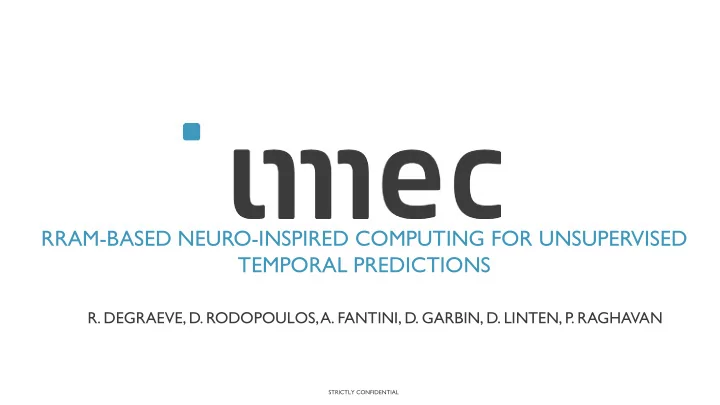

RRAM-BASED NEURO-INSPIRED COMPUTING FOR UNSUPERVISED TEMPORAL PREDICTIONS R. DEGRAEVE, D. RODOPOULOS, A. FANTINI, D. GARBIN, D. LINTEN, P. RAGHAVAN STRICTLY CONFIDENTIAL
OUTLINE & PURPOSE Purpose Show a learning algorithm that exploits the physical properties of RRAM as true imitation of synaptic connections Resistive RAM properties Algorithm Discussion and analysis Conclusions 2 STRICTLY CONFIDENTIAL
O-VACANCY RRAM = TUNABLE CONDUCTIVE FILAMENT BUT STOCHASTIC BEHAVIOR MAKES IT AN UNRELIABLE STORAGE ELEMENT TE TE BE BE Broad distribution at both low and high resistive state Stochastic behavior after program, after read and as a function of time Extremely unsuited as a stable ‘weight’ element 3 STRICTLY CONFIDENTIAL
TRUE RRAM PROPERTY = STABLE MEAN BEHAVIOR PHYSICS = STABLE NUMBER OF VACANCIES IN FILAMENT CONSTRICTION TE BE Switch from high to low resistance = abrupt due to positive feedback effect Repeated stimuli result in stable mean filament growth BUT = read-out remains wide distribution & stochastic 4 STRICTLY CONFIDENTIAL
WHAT ALGORITHM TAKES BEST ADVANTAGE OF RRAM PROPERTIES? CONTINUOUS LEARNING OF TEMPORAL DATA One-hot encoded frames T emporal data Store sequence and context as a =frames/time unit 2-dimensional pattern in a RRAM array T emporal context from history Algorithm example Step (i) STEP 1: open the new frame to all One-hot encoded 00000100...000 Frame W i contexts Duplication for 3 00000100...000 00000100...000 00000100...000 contexts = (WW) i 5 STRICTLY CONFIDENTIAL
STEP 2: CHECK PREVIOUSLY SEEN SEQUENCE STEPS RRAM ARRAY IN READ MODE @ LOW VOLTAGE Step (ii) read mode 00000100...000 Read possible existing connections between new state and previous state (WW) i-1 00000000...000 Parallel reading RRAM array V read . Simply checking whether current > threshold 00000000...000 V sel =select voltage V G,CC =gate V for given current compliance 01000000...000 01000000...000 (WW) i 01000000...000 V sel =V G,CC V sel =V G,CC V sel =V G,CC 6 STRICTLY CONFIDENTIAL
STEP 3: FIND EXISTING CONNECTIONS AIM= EACH CONNECTION IS PROGRAMMED ONLY ONCE Existing connection is detected in same context Existing connection is detected in a different context No connection exists yet 7 STRICTLY CONFIDENTIAL
STEP 4 : PROGRAMMING SEQUENCE AS RRAM CONNECTION PROGRAM VOLTAGE AND PULSE LENGTH ARE ALWAYS THE SAME New input is restricted to the selected column Programming step Either makes a new connection between previous and new state Either confirms an existing connection and strengthens it Current is limited by driving transistor V program = 1.5V for t=100ns 8 STRICTLY CONFIDENTIAL
STEP 5: SHIFT OPERATION SYSTEM IS READY FOR NEXT INPUT Sequence of abstract data= A-F-R-S-D-E-A-X-B 2D- pattern of connections Each step in the time sequence adds 1 connection or strengthens an existing one Time sequence is casted into the RRAM array as a 2D pattern 9 STRICTLY CONFIDENTIAL
PREDICTING DATA =READING STEP DATA CAN BE PREDICTED BY READING WITH ALL COLUMNS SELECTED 00000100...000 Predicting next data frame (WW) i-1 Read all possible connections starting from the 00000000...000 context-sensitive last known frame RRAM array V read . = union of predictions 00000000...000 Current levels has statistical meaning identifying most likely prediction 000000100000100000000000010010000000 (PP) i collapse to (P) i = union of predictions V sel =V G,CC READ output current 10 STRICTLY CONFIDENTIAL
FLOW CHART ALGORITHM FOR CONTINUOUS UNSUPERVISED LEARNING (W) i i i+1 Replication of (W) i to (WW) i Read mode Expand (W) i-1 new (WW) i-1 Locally stored V read *(WW) i-1 is applied to input 1-bit (WW) i-1 V G,CC *(WW) i is applied to selector lines V=0 is applied to output lines Read (output) V read *(WW) i-1 is applied to input no V G,CC *(WW) i is applied to selector lines Winning column ? V=0 is applied to output lines I read > I threshold yes no Winning column ? Random choice (WW) i is reduced to 1 ON bit content I read > I threshold from selection Program mode yes V program *(WW) i-1 is applied to input V G,CC *(WW) i is applied to selector lines V=0 is applied to output lines See my poster stand for details and discussion 11 STRICTLY CONFIDENTIAL
HARDWARE PROOF ON RRAMTEST CHIP SIMPLE VERSION OF ALGORITHM DEMONSTRATES FEASIBILITY Technology with capped 5 nm HfO or TaO layer and TiN electrode Crossbar test structures Simple example of algorithm and measured corresponding conductance 12 STRICTLY CONFIDENTIAL
SIMULATED CONTROL EXAMPLES SHOW OPERATION Periodic function is translated as loop of connections Two periodic functions = 2 loops with weaker interconnects Noisy function adds several unwanted connections 13 STRICTLY CONFIDENTIAL
SUPPRESSION OF INFREQUENT CONNECTIONS BY READ DISTURB SOLUTION FOR COPING WITH NOISE IN DATA Read during predict weakens connections Only the trained connection is confirmed again Over-programming avoided by using read disturb mechanism as forget mechanism V read = -0.5 V causes a small (non-abrupt) reset to high resistive state 14 STRICTLY CONFIDENTIAL
HIERARCHICAL STRUCTURE FOR MORE COMPLEX BEHAVIOR TIME SEQUENCES ARE DIVIDED OVER SHORT AND LONGER TERM STRUCTURE At each decision point in level 1, we address level 2 both read and program Level 1 = organization of states in temporal groups Level 2 = organization of temporal groups in larger groups 15 STRICTLY CONFIDENTIAL
CONTROL ILLUSTRATES OPERATION AND EFFECTIVENESS Symmetric saw tooth has each point in two contexts Indistinguishable with connection strength Hierarchical approach is effective 16 STRICTLY CONFIDENTIAL
SUMMARY & CONCLUSIONS Find a way to exploit filamentary RRAM properties in a learning algorithm Our answer Continuous unsupervised learning Temporal data Hardware implementable Filamentary RRAM used as stochastic memory technology Read and program are at constant voltage and time Read disturb as forget mechanism Sequence of data is stored as a structured 2D network of hardwired connections with statistical properties 17 STRICTLY CONFIDENTIAL
Recommend
More recommend